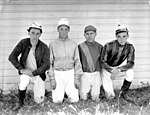Jockey's cap

A jockey's cap is the headgear worn by a jockey in the sport of horse racing. The modern jockey's cap forms part of a jockey's "silks" or racing colours and is worn over a protective equestrian helmet.
History
The first form of jockey's cap appeared in the late 17th century and was generally made of velvet with a peak or visor and a hatband fastened at the front with a buckle.[1] This early style of cap is preserved in the "State Dress" of the musicians of the Household Cavalry, who adopted it at the behest of Queen Victoria.[2] During the 19th century, a lighter version began to be worn by racing jockeys;[1] it was made of silk in the colours representing the jockey's stable.[3] Modern jockey's caps are made oversized so that they can be worn over a protective helmet.
Gallery
-
Bandsmen of the Household Cavalry mounted band in state dress, wearing the traditional style of velvet jockey's cap.
-
A British jockey with silk cap in 1862.
-
American jockeys with caps in 1922.
-
Modern jockey with head and eye protection.
References
- ^ ISBN 978-1847885333.
- ^ Toffoli, Garry. "The Guards". crht.ca. Canadian Royal Heritage Trust. Retrieved 20 December 2018.
- ISBN 978-0486402949.




